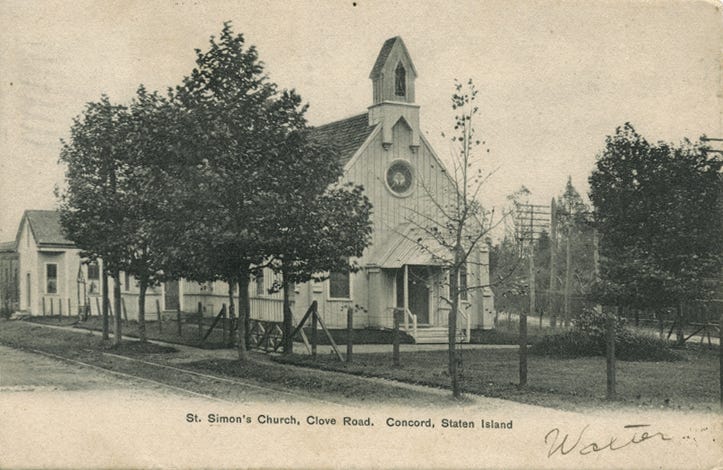St Simon was a Zealot. Zealots were one of four known political parties in Jesus’ day. The other three being Pharisees, Sadducees, and Essenes. I should write about them some day. Suffice to say, Zealots were the alt-right EthNats of the first century. They advocated for racial purity and the physical removal of the Roman Empire to create a Jewish ethnic state. Zealot is also a Greek word. In Hebrew they were called Kana'im. It’s a bit ironic, as Disciple would not be a far-away translation of Zealot into English.
Syrian tradition details that Simon was bitten by a snake. Jesus healed him, and having saved his life, he seems to have let go of the EthNat ideology to some degree and followed him.
St Simon is also a common church name. One such church, St Simon’s Episcopal Church, is near to my parent’s house.
St Simons is a mobile church of sorts. It had an older building on the island. Built a bit Easterly from this site. There’s still some photos of it:
Founded as St. Simon's Free German Chapel of the Protestant Episcopal Church, it was built for a strange syncretism of continental and insular Protestantism. Tragically, this St Simons had to go, because Robert Moses demanded the land for a highway. And so, about a century after its construction, it was cleared away.
St Simon’s Episcopal Church reestablished itself a bit west from the highway, atop a hill. With a cool modern roofing system and some funky work with the altar.
Growing up, I had a great deal of reverence to the Anglican tradition. Innocent reverence. I had no knowledge of their progressive views. I just found it quaint that there was an English Speaking church that seemed to have maintained a Catholic tradition of sorts in that controversial Island of Europe. Officially, Anglicanism started with King Henry the VIII’s divorces. I always found this a weak reason to start a church, and I investigated the background of why the split happened. As it happened, the English speaking church had been in and out of communion with Rome a number of times. Anglicanism was merely the Reformation incarnation of this unhealthy arranged marriage with Rome. The actual origins of the Anglican Church appear to go back to the Dark Ages with disagreements on aesthetics. Anglican monks did not wear the Roman haircut, but the ancient druid haircut.
I later learned that by and large, the British Monks of the Dark Ages were, in fact, merely druid converts. And that by and large many of the Tolkienisms we are familiar with among Celtic traditions are a product of much of this tradition being carried over from the Druid priests who accepted Christ. It appears this was by and large a product of St Columb. A mystic Irish Priest who, supposedly, created something of a syncretic religion between the native Druids and the Roman Christian beliefs. He founded a monastery on Iona where he trained Druids in the priestly responsibilities of Christianity. And thus was born a new flavor of Christian belief among the British.
Perhaps the most amusing statement declaring Anglicanism apart from Romanism can be found in a declaration from the Synod of Whitby in 664 AD:
Britones toti mundo contrarii, moribus Romanis inimici, non solum in missa sed in tonsura etiam
Or in English:
"Britons are contrary to the whole world, enemies of Roman customs, not only in the Mass but also in regard to the tonsure"
heh…
Sadly as I grew older, I learned what became of this rather amazing historic tradition. Its watering down of truth, it’s abandonment of tradition. Certainly they are not as bad as others like the ELCA. There is still time for correction. But it is thus such a horrible tremendous fall for the Anglican Church to go from something very local and part of the British tradition to something watered down and wishy washy that it is today…at least the Isle version. African Anglicanism continues strong luckily. Perhaps redemption will be found there…
St Simons by my parents was no exception. As the watering down continued, people left looking for something better. Children found nothing gripping of the faith, and walked away. Until about 20 years ago, the congregation began to rely on renting the space to other groups to stay afloat. “Amazing Grace Interfaith Ministry” took that rent. One of those bizarre pseudo-universalist abominations that the Episcopal church occasionally gives birth to. The ELCA does this too, but that’s for another time.
But alas, even co-opting pagans and heretics couldn’t support St Simon’s for long. And so in mid 2019, even before the pandemic could have finished her off, St Simons closed for good. Later during the pandemic, it was fully liquidated to a developer for the lofty price of $6 Million. Quite a cash grab for a declining denomination. Perhaps that’s some vital life support for others.
I knew none of this up until yesterday. When, during an Uber trip, I looked out my window and saw a crater.
It is eerie how similar this photo looks to the original St Simon’s after Robert Moses’ parting of the land for his highway. I had been for some time curious how God might deal out justice against such abominations as I’ve mentioned. This degree of temporal symmetry hits me hard. I had thought perhaps it would be a property bought by a different denomination, or maybe it would be turned into a store. I had no expectation of this heavy justice from the Lord. But such is the fate of worldly churches. If you enter the sea of the gentiles without holding fast to the truth of Christ, this is where you will end up in but a generation. 165 years turned to dust.
Requeiscate de pache, St Simon’s. May your fate remind the faithful of their duties.









